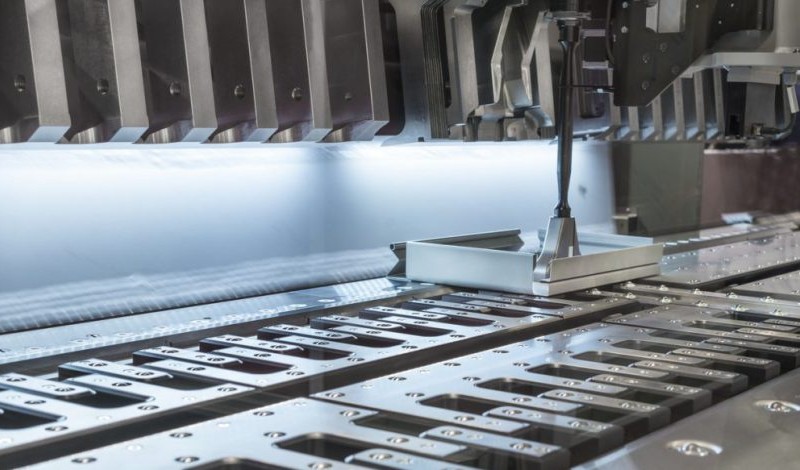Metal Stamping: Technologies Driving Sector Development
Metal Marking Advancements: Elevating Manufacturing Processes for Superior Outcomes
In the world of producing procedures, metal stamping has long been a cornerstone technique for producing an array of accuracy parts. With the unrelenting march of technical innovation, the landscape of steel marking is undergoing a significant change.
Evolution of Metal Stamping Techniques

In addition, developments in product scientific research have resulted in the advancement of high-strength alloys that can currently be effortlessly stamped right into detailed shapes, dealing with a wider series of commercial applications. The assimilation of robotics and expert system has additionally maximized the marking procedure by enhancing speed and accuracy while minimizing the threat of human error.

Influence of Advanced Materials
Have innovative products transformed steel stamping processes significantly in the production market? The answer is an unquestionable yes (Metal Stamping). The combination of sophisticated products has actually transformed steel marking, enabling manufacturers to attain greater accuracy, boosted effectiveness, and enhanced item high quality. By using materials such as high-strength alloys, advanced composites, and innovative layers, steel marking procedures can now produce components that are lighter, stronger, and much more resilient than ever in the past.
These innovative products provide premium mechanical buildings, corrosion resistance, and thermal stability, enabling makers to fulfill the needs of modern-day industries such as aerospace, automotive, and electronics. Furthermore, using innovative products in steel stamping has assisted in the manufacturing of intricate geometries and complex designs that were previously unattainable through conventional approaches.
Moreover, the execution of sophisticated materials has resulted in reduced product waste, reduced manufacturing prices, and shorter lead times, making metal marking procedures a lot more affordable and lasting. As technology continues to advance, the influence of innovative products on metal stamping procedures is anticipated to drive additional advancement and improve the competitiveness of producers in the worldwide market.
Automation in Steel Stamping
The advancement of steel marking processes driven by the integration of advanced products has actually set the stage for substantial advancements in automation within the production market. Automation in metal marking has revolutionized manufacturing processes, enhancing performance, accuracy, and overall result top quality. With the utilization of robotics, sensing units, and computer-controlled systems, tasks that were as soon as hands-on and lengthy can currently be implemented with unparalleled rate and precision.
Automation in metal marking not only increases manufacturing rates however additionally guarantees uniformity in the manufacturing procedure. By reducing human treatment, the risk of errors is dramatically decreased, leading to higher degrees about his of product uniformity and reliability. Furthermore, automation enables makers to undertake intricate stamping jobs that would be challenging or not practical to accomplish manually.
Additionally, automation in metal stamping contributes to a safer working setting by minimizing the need for workers to take part in hazardous or recurring jobs - Metal Stamping. This change towards automation not only boosts productivity however additionally leads the means for the future of manufacturing, where innovation plays a main duty in driving functional quality
Quality Control and Assessment Equipments
With a concentrate on precision and reliability, quality assurance and examination systems play an important duty in guaranteeing item excellence in steel marking processes. These systems are designed to keep track of every stage of manufacturing, from product assessment to the last product, to guarantee that all elements fulfill the needed requirements. By applying advanced modern technologies such as optical inspection systems, coordinate determining machines (CMM), and automated determining devices, manufacturers can discover also the tiniest variances in measurements, surface top quality, and total integrity of stamped components.

Sustainability Practices in Steel Stamping
Structure upon the foundation of precision and dependability developed via quality assurance and examination systems, the combination of lasting methods in metal stamping processes is increasingly becoming a centerpiece for suppliers looking for to reduce environmental effect and maximize source utilization. Sustainability practices in steel marking incorporate a variety of initiatives intended at lowering waste generation, energy consumption, and greenhouse gas emissions throughout the production process.
One key facet of sustainability in steel stamping is the fostering of environmentally friendly materials and technologies that advertise recyclability and waste decrease. By utilizing recycled materials and executing energy-efficient machinery, suppliers can reduce their carbon footprint and contribute to an extra lasting manufacturing cycle. In addition, enhancing look at this website production procedures to decrease product waste and power usage not only benefits the atmosphere but likewise brings about set you back savings for businesses in the future.
Furthermore, the implementation of sustainable methods in metal stamping can improve brand online reputation and allure to ecologically conscious consumers. As sustainability remains to obtain relevance in the manufacturing sector, incorporating eco-friendly initiatives right into steel marking procedures is essential for lasting success and competitiveness on the you could look here market.
Verdict
In verdict, steel marking methods have actually dramatically progressed over time, including advanced products and automation to boost making processes. Quality control and assessment systems play a crucial role in making sure exceptional results, while sustainability methods are progressively being carried out to lower environmental effect. These technologies in steel marking have actually changed the sector, bring about much more effective and lasting production techniques for various industries.
Metal stamping, when a handbook and labor-intensive process, has transformed right into an extremely automated and innovative approach of forming steel sheets right into different types and designs.Have advanced materials changed steel marking procedures dramatically in the production sector? By using materials such as high-strength alloys, advanced composites, and innovative finishes, steel stamping processes can now generate components that are lighter, stronger, and extra resilient than ever before.
The development of metal marking procedures driven by the assimilation of innovative materials has actually established the phase for considerable advancements in automation within the production sector.In verdict, metal marking techniques have significantly evolved over time, incorporating advanced materials and automation to enhance making processes.